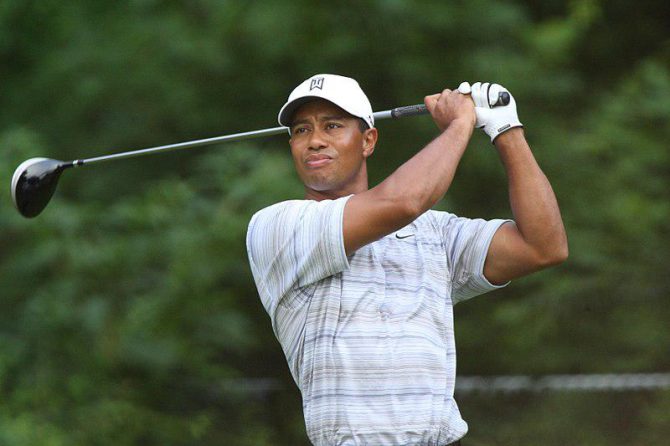1. Fundamental Principles of Tiger Woods’ Swing Technique
****
Grip
Tiger Woods’ grip is one of the most recognizable in golf. He uses a neutral grip, with his left hand slightly stronger than his right. His hands are positioned fairly low on the club, and his thumbs are placed on the outside of the grip. This grip allows him to generate a lot of power and control with his swing.
Stance
Woods’ stance is also very distinctive. He stands slightly wider than shoulder-width apart, with his feet turned slightly outward. His knees are bent slightly, and his weight is distributed evenly between his feet. This stance gives him a solid base from which to swing, and it allows him to generate a lot of power.
Backswing
The backswing is the first part of the golf swing, and it is where Woods generates power. He takes the club back slowly and smoothly, keeping his head down and his eyes focused on the ball. As he reaches the top of his backswing, his club is parallel to the ground and his weight is shifted to his right side.
2. Biomechanical Analysis of Woods’ Impact Dynamics
****
Tiger Woods’ swing generates tremendous force, imparting significant impact dynamics on the golf ball. Understanding these dynamics is crucial for optimizing club selection and swing technique.
Kinetics and Impact Forces
The ball’s initial velocity and trajectory are primarily determined by the impact force and spin imparted by the clubhead. Woods’ aggressive swing produces high clubhead speeds, resulting in impact forces exceeding 2,000 pounds. This force compresses the ball, transferring kinetic energy to it. The ball’s spin also plays a crucial role, influencing its trajectory and height.
Clubhead-Ball Interaction
The clubhead’s loft (angle between the clubface and shaft) and dynamic drag affect the ball’s impact. Woods often employs drivers with higher lofts, which provide greater forgiveness and launch angle. By modulating his swing path and clubhead orientation at impact, he can produce an optimal trajectory, combining distance and accuracy.
| Clubhead Loft | Impact Dynamics |
|---|---|
| Low Loft (Driver) | Higher ball speed, flatter trajectory, longer distance |
| High Loft (7 Iron) | Lower ball speed, steeper trajectory, shorter distance |
Tiger Woods’ Golf Pedagogy: A Comprehensive Analysis
Tiger Woods is widely regarded as one of the greatest golfers of all time. His success can be attributed to a number of factors, including his exceptional physical skills, his mental toughness, and his understanding of the game.
In this section, we will explore the cognitive factors and mental strategies that have contributed to Woods’ success on the golf course.
Cognitive Factors
- High Level of Mental Processing (LMP): Implies continual collection and analysis of feedback during the swing, searching for errors via internal/external cues, positive reinforcement and a high degree of learning capacity/flexibility.
- Mental Imagery and Visualization: Ability to vividly imagine and visualize the desired swing, target, and outcome, allowing for fine-tuning of technique while also establishing connectivity between performance and desired outcome.
- Self-Talk: Usage of positive, motivating, and instructive self-talk to maintain focus, boost confidence, reduce stress and anxiety, and facilitate a problem-solving approach with quick adjustments.
- Attention Control: Ability to maintain focus on relevant stimuli while ignoring distractions, allowing for improved concentration and performance under pressure.
Mental Strategies
- Pre-Shot Routine: Standardized routine before each shot that includes elements of deep breathing, visualization, positive affirmations, and focusing on breathing. Helps to establish a sense of calm and control, while also promoting consistency and accuracy.
- Shot Shaping: Ability to intentionally manipulate the flight and trajectory of the golf ball to match the desired target and playing conditions, promoting versatility and adaptability.
- Course Management: Strategic approach to playing the course that takes into account factors such as wind conditions, hazards, and the player’s skills, aiding in shot selection and optimal decision-making.
- Emotional Control: Regulation of emotions and stress during competition, allowing for optimal performance under pressure, ability to bounce back from mistakes, and maintain a positive mindset.
Table 1: Key
| Cognitive Factor | Mental Strategy | Description |
|---|---|---|
| Mental processing high level | Pre-shot routine | Established calmness, control, consistency, and accuracy |
| Mental Imagery and Visualization | Shot shaping | Versatility and adaptability |
| Self-Talk | Course management | Optimal decision making |
| Attention Control | Emotional Control | Ability to bounce back from mistakes, optimal performance under pressure, and positive mindset |
Distance Control
- Three-ball drill: Place three balls at varying distances from the hole (e.g., 5, 10, and 15 feet). Attempt to hole all three balls in succession, focusing on smooth tempo and consistent stroke length.
- Ladder drill: Set up a series of cones or tee markers at increasing distances from the hole. Start with a shorter putt and gradually move back, aiming to make putts consistently at each distance.
Accuracy Drills
- Gate drill: Place two parallel sticks a few inches apart on either side of the intended putting line. Practice putting the ball through the “gate” to improve alignment and accuracy.
- Artificial break drill: Create artificial breaks on the putting green by placing a book or other object in the path of the ball. This forces you to adjust your aim and compensate for the altered line.
Tiger Woods’ Golf Pedagogy: A Comprehensive Analysis
In this comprehensive analysis, we have explored the various aspects of Tiger Woods’ golf pedagogy. We have examined his swing technique, his approach to practice, and his mental game. We have also discussed his influence on the game of golf.
Woods is one of the most successful golfers in history, and his pedagogy has played a major role in his success. He has a unique and effective swing technique that is based on sound fundamentals. He also has a relentless work ethic and is always striving to improve his game. Woods is also a master of the mental game, and he is able to stay focused and composed under pressure.
Woods’ influence on the game of golf has been profound. He has inspired a generation of young golfers and has helped to make the game more popular than ever before. He is a true legend of the game, and his pedagogy will continue to be studied and admired for years to come.





